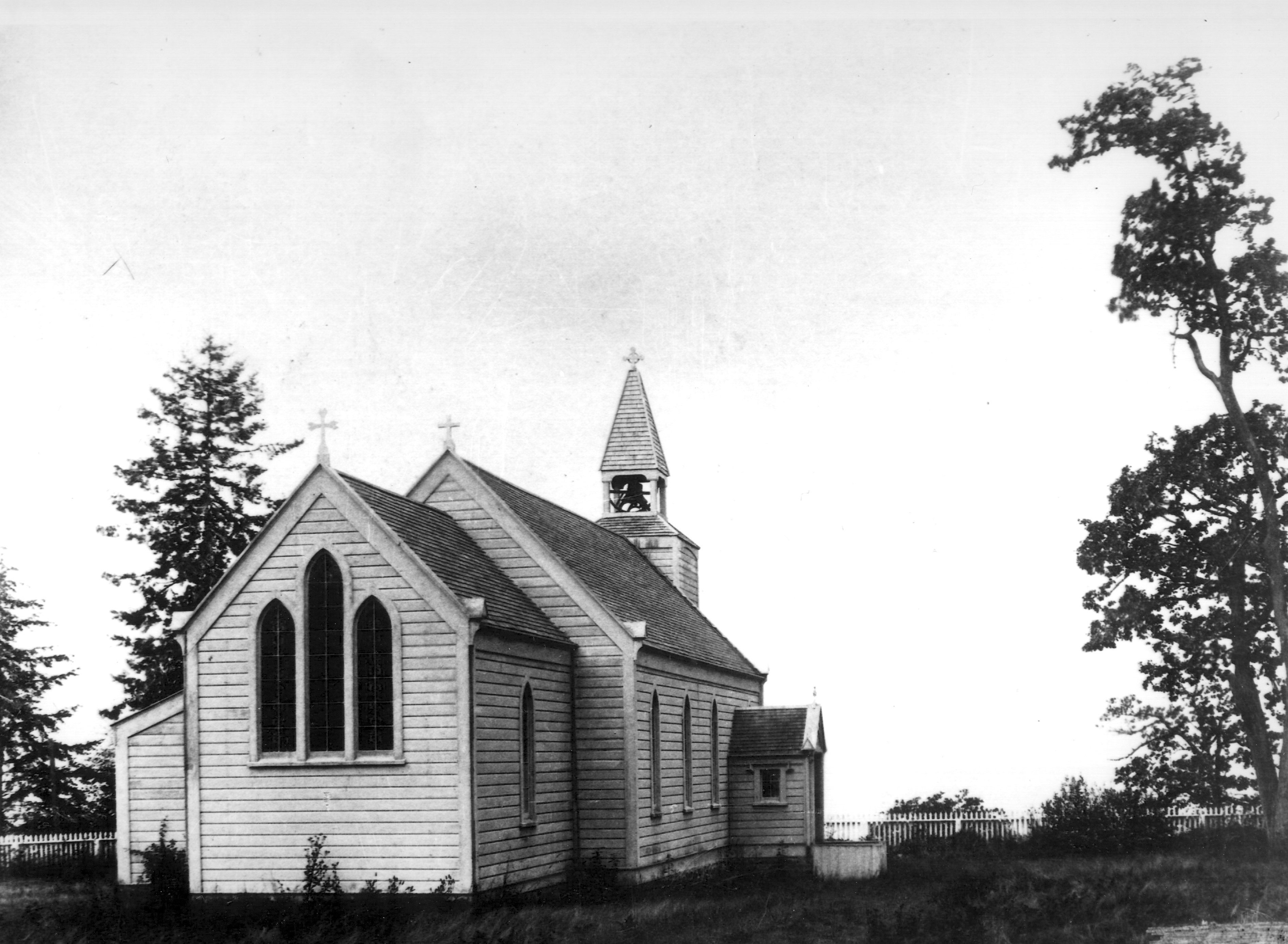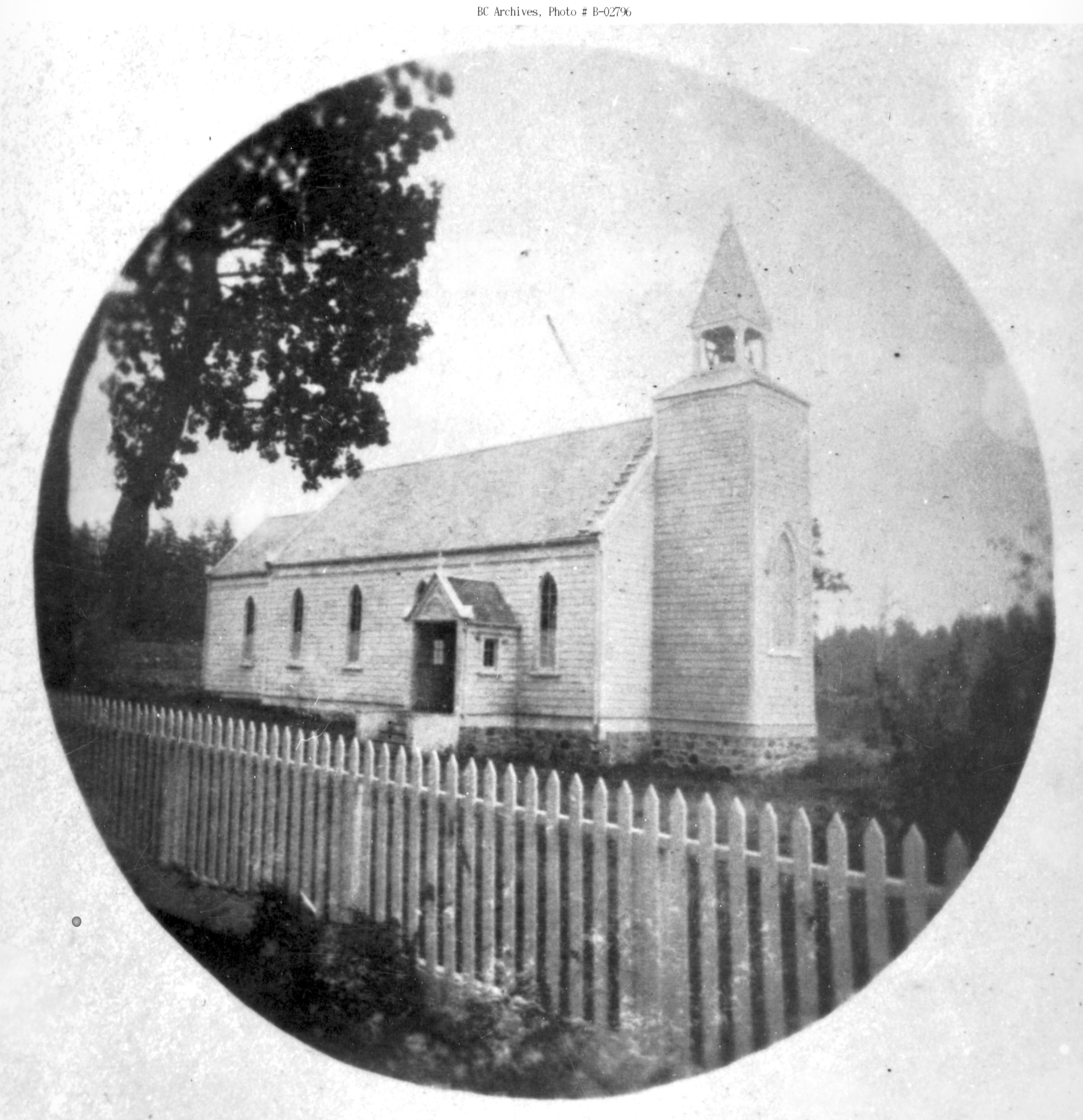By 1884, the number of settlers had increased significantly on the north end of Saanich Peninsula, and a substantial number of these professed to be members of the Church of England. There arose a desire among the members of this new community to build a church for those devoted to the Anglican faith. The names that appear on the documents associated with the move to build the church are Brackman, Collins, Downey, Horth, Ker, Mills, McIlmoyl and Roberts.
In 1884, George Mills donated the site for the church and parsonage in 1875. He had purchased the large farm from Rufus and Charles Horth, and a verbal agreement had been made that some of the property should be given for a church site.
The lumber was rafted south from Genoa Bay. A Deep Cove resident, Mr. Charles Wales, made a raft of the lumber and brought it down the channel taking advantage of the tides and currents. It took several days as he propelled his raft with long oars or "sweeps". Settlers living along the coast prepared food for him and took the food out to the raft by boat.
All the preliminary work for the construction - clearing, excavating, laying the foundation, moving the lumber - was done using voluntary labour. After design by Victoria architect, John Teague, the contract for the building of the church was awarded to T.B Shaw, builder of St. Stephen's Anglican Church and several other churches on the Island.
.jpg)
Photo Credit: BC Archives
Holy Trinity was consecrated in 1885 by the first Bishop of Columbia, Rt. Rev. George Hills, who travelled from Victoria accompanied by his archdeacon and three clergy. The event was described in the Church News, a portion of which follows:
"The new church at North Saanich has been completed and on Saturday, June 27th, it was solemnly set apart for sacred uses, and dedicated to 'the Holy and Undivided Trinity'.
We have not space for a detailed description of the church, suffice it to say it is a commodious, substantial and handsome structure capable of comfortably seating 150 persons, and that it has proved a very inexpensive one, the total cost having been only $1200.00."
Since the original construction of the church, several modifications have been made. The first was the addition of a bell tower in 1889. The bell was cast by Clinton H. Morley, Bell Foundry, Troy, N.Y. To the joy of all, the bell was rung for the first time on Easter Day, 1889. In 1893, the east window of tinted glass was placed in memory of Henry Brackman, a founding member of Holy Trinity Church.
In 1921, the church was given a much-needed refurbishment. The chancel was entirely renovated. The altar was raised and three steps leading up to it added; the lower part of the walls were paneled, and a year or so later the upper part was plastered and stenciled in a blue and gold pattern symbolizing the Trinity. Outside, the roof was mended and eaves were added. Later, the walls were shingled and stained brown. In 1927, all of the windows except the east window were replaced with tinted glass. Each window is in memory of a parishioner. An oak panel on each sill identifies the memorial.
Until 1948, at the wish of the parishioners, there were no electric lights in the church. In that year, lights were installed by the family of General Gwynne in his memory. In 1954, the choir vestry was added on the north side and in 1981 the main entrance was enlarged.

Photo Credit: BC Archives
The Churchyard
The original churchyard was about one-half an acre surrounding the church and was planned to accommodate 200 burial plots. The first burial was for the donor of the land, Mr. George Mills, who died on February 1, 1888 at the age of 54. On August 30, 1891, the churchyard was expanded to the east and the Bishop then declared all the burial area to be a cemetery. The cemetery was enlarged on two other occasions until it assumed its present size of two acres and 1700 plots.
Many pioneers of the Saanich Peninsula are buried in Holy Trinity Cemetery. At least 20 area roads and geographic features bear names of cemetery occupants. An example is "Mills Road" fronting the cemetery. This road was originally called "School House Road" but the name was changed to honour the local farmer and donor. Many plots have no marker stones indicating the names and dates, but there are hand-written receipts, maps, lists and other records made by sextons and wardens over the years.
Several marker stones and cemetery records show the burial of children in the early years of the church and the effects of the two World Wars on the congregation. Some indicate the affiliation of the occupant with the Canadian Forces, the RCMP and various fraternal organizations. The rank or position of the person is often shown. Probably the most significant is the plot of George Pearkes, Canadian Army General and Lieutenant Governor of B.C. Of the 19 ministers who have served Holy Trinity Church, 5 (including the first Rector, Rev. T.M. Hughes) are buried in the cemetery. Of lesser renown was crewman Andrew Ollson who perished in the sinking of the SS Iroquois off Sidney in 1911.
Early plans of Holy Trinity Cemetery included trees which were planted on the south and west boundaries. Many of these trees are native Douglas fir, but some exotic trees are included, and are found also in the cemetery itself. Over two dozen flowering or ornamental trees are present including flowering cherry and plum, lilac, garry oak and English oak, American elm, copper beech, birch, dogwood, Coulter and Scots pine, cedrus and spruce. Two trees which have dedication plaques are an English oak from Windsor Great Park and a Scots pine from Kew Gardens. Both were planted to commemorate the coronation of King George VI in 1937.

Photo Credit: BC Archives
The two most conspicuous marker stones or monuments are for people who are not buried in the cemetery. A large stone cross and identification marker located at the end of the cemetery road is in memory of Rev. Roy Melville, the sixth rector of the church. However, there is no record of Rev. Melville's burial in Holy Trinity Cemetery. On the east central part of the cemetery is a tall granite obelisk naming three young soldiers who drowned in a boating accident near Sidney. They were neither parishioners nor residents of this area, but the Canadian Legion arranged for the manufacture and inscription of the monument and its placement in the cemetery.
In 1948, a building was moved from church property to Frank Edlington's farm on McTavish Road. The recipient states, and many agree, that this building was the first North Saanich elementary school, and that it had been relocated to Holy Trinity Church to provide a morgue for the RCAF at Patricia Bay during the WWII period.
The lychgate was given in 1955 by Mr. and Mrs. J.M. Taylor in memory of their son who was killed in WWII. It was designed by Mr. H.H. German and the work was executed by Mr. H.G. Horth, son of one of the church founders.
In 1980, Holy Trinity and St. Andrew's, Sidney separated into independent parishes. The cemetery, however, remained a joint responsibility and is now managed by a Cemetery Board of the rectors and representatives from both parishes.
The passing of time and change of equipment is noted in Holy Trinity Cemetery. The early hand-scripted ledgers of burials and plots have been replaced by computer data bases and location/name files on disks. The hand-hewn marker stones (some with misspellings and chiseling problems) are now made from the same stone but with computer-directed carbide routers which can carve any kind of print or script and any scene or design considered appropriate.
The Church Hall
In 1960, the parish purchased a war-surplus building which had to be moved from the airport to its present site just east of the Church. The land on which it is located was leased from the Federal Ministry of Transport for the nominal sum of $50 per annum. The hall was officially opened by Archbishop Sexton on May 4, 1962. In 1984, the parish purchased the land where the hall is situated.
A booklet with a more extensive history, "Holy Trinity Church 1885 - 1985" may be purchased from the church office.
